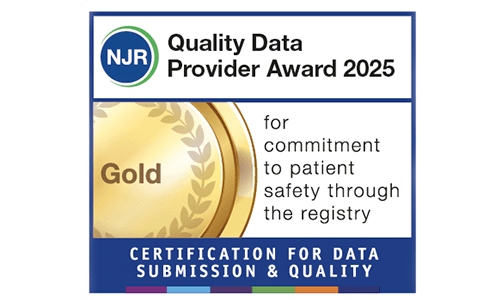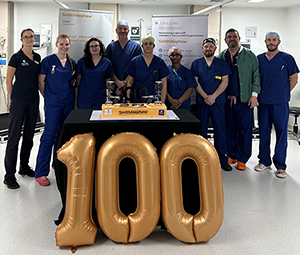Trigger Finger Release Specialists at West Midlands Hospital
-
Mr Sujit Agarwal
Orthopaedics
Mr Sujit Agarwal is a Consultant Trauma & Orthopaedic Surgeon in Halesowen, West Midlands
View Profile -
Mr Mushtaq Ahmed
Orthopaedics
Mr Ahmed is a Consultant Orthopaedic surgeon in the West Midlands, specialising in Sports injuries, Arthroscopic Knee Surgery and treatment of lower back pain
View Profile -
Mr Tanweer Ashraf
Orthopaedics
Mr Tanweer Ashraf is a Consultant Orthopaedic Surgeon, specialising in Knee Surgery in the West Midlands
View Profile -
Mr Rajeev Bansal
Orthopaedics
Mr R Bansal is a Consultant Orthopaedic Surgeon in Halesowen, West Midlands who specialises in shoulder and elbow surgery.
View Profile -
Mr Muhammad Sohail Butt
Orthopaedics
Mr Sohail Butt is a Consultant Orthopaedic Surgeon in the West Midlands, specialising in shoulder, elbow, hand and wrist surgery
View Profile -
Mr Fouad Chaudhry
Orthopaedics
Mr Fouad Chaudhry is a Consultant Trauma and Orthopaedic Surgeon in the West Midlands specialising in hip and knee surgery
View Profile -
Mr Kishore Kumar Dasari
Orthopaedics
Mr Kishore Dasari is a Consultant Orthopaedic Surgeon specialising in foot and ankle surgery, working in West Midlands.
View Profile -
Professor Edward Davis
Orthopaedics
Professor Davis is a Consultant Orthopaedic Surgeon in Stourbridge and the West Midlands, specialising in hip and knee surgery
View Profile -
Mr Kenan Dehne
Orthopaedics
Mr Kenan Dehne is a Consultant Orthopaedic Surgeon in the West Midlands, specialising in Hip and Knee Surgery
View Profile -
Mr Kowshik Jain
Foot and Ankle Disorders
Mr Kowshik Jain is a Consultant Orthopedic Surgeon in the West Midlands who specialises in Foot and Ankle Surgery
View Profile -
Mr Arun Kozhikunnath
Orthopaedics
Mr Arun Kozhikunnath is a Consultant Orthopaedic Surgeon working in the West Midlands, specialising in foot and ankle surgery.
View Profile -
Mr Edward Laugharne
Orthopaedics
Mr Edward Laugharne is a Consultant Orthopaedic Surgeon in Halesowen, West Midlands who specialises in hip and knee replacement surgery.
View Profile -
Mr Andraay Leung
Spinal Surgery
Mr Leung is a Consultant Orthopaedic Spinal Surgeon in the West Midlands.
View Profile -
Mr Sabur Malek
Orthopaedics
Mr Sabur Malek is a Consultant Orthopaedic Surgeon in the West Midlands who specialise in Hip and Knee Surgery
View Profile -
Mr Alastair John Niall Marsh
Orthopaedics
Mr Alastair John Niall Marsh is a Consultant Orthopaedic Surgeon in the West Midlands, specialising in Foot and Ankle Surgery.
View Profile -
Mr Doraisami Mohan
Orthopaedics
Mr Doraisami Mohan is a Consultant Orthopaedic Surgeon working in the West Midlands.
View Profile -
Mr Rajpal Nandra
Orthopaedics
Mr Rajpal Nandra is a Consultant Orthopaedic Surgeon working in the West Midlands, who specialises in hip replacements.
View Profile -
Mr Vishal Paringe
Orthopaedics
Mr Vishal Paringe is a Consultant Orthopaedic Surgeon, specialising in Hip and Knee Surgery
View Profile -
Mr Qutub Qadri
Orthopaedics
Mr Qutub Qadri is a Consultant Orthopaedic Surgeon specialising in hip, knee, foot and ankle, working in the West Midlands.
View Profile -
Mr Sohail Quraishi
Orthopaedics
Mr Sohail Quraishi is a Consultant Orthopaedic Surgeon in the West Midlands who specialises in hip and knee surgery.
View Profile -
Mr Maneesh Sinha
Orthopaedics
Mr Maneesh Sinha is an Orthopaedic Consultant in the West Midlands specialising in upper limb surgery
View Profile -
Mr Manoj Veettil
Orthopaedics
Mr Manoj M Veettil is a Trauma & Orthopaedics Consultant in the West Midlands who specialises in Hip and Knee surgery
View Profile -
Mr Matthew Waites
Orthopaedics
Mr Matthew Waites is a Consultant Orthopaedic surgeon in the West Midlands who specialises in Hip and Knee surgery
View Profile


